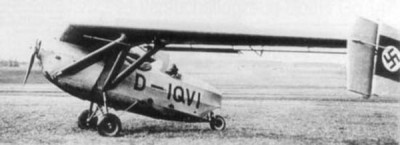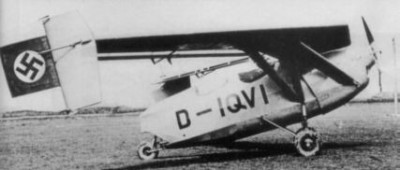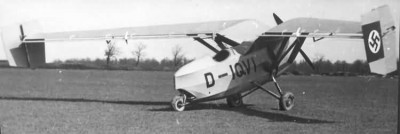| Název: Name: | Gotha Go 147 B | Gotha Go 147 B |
| Originální název: Original Name: | Gotha Go 147 B | |
| Kategorie: Category: | experimentální letoun | experimental aeroplane |
| Výrobce: Producer: | DD.MM.1936-DD.MM.1937 Gothaer Waggonfabrik AG, Gotha | |
| Období výroby: Production Period: | DD.MM.1936-DD.MM.1937 | |
| Vyrobeno kusů: Number of Produced: | 2 prototypy | |
| První vzlet: Maiden Flight: | DD.12.1937 | |
| Osádka: Crew: | 2 | |
| Základní charakteristika: Basic Characteristics: | ||
| Vzlet a přistání: Take-off and Landing: | CTOL - konvenční vzlet a přistání | CTOL - conventional take-off and landing |
| Uspořádání křídla: Arrangement of Wing: | jednoplošník | monoplane |
| Uspořádání letounu: Aircraft Concept: | bezocasé | tailless |
| Podvozek: Undercarriage: | pevný | fixed |
| Přistávací zařízení: Landing Gear: | kola | wheels |
| Technické údaje: Technical Data: | ||
| Hmotnost prázdného letounu: Empty Weight: | 945 kg | 2083 lb |
| Vzletová hmotnost: Take-off Weight: | 1145 kg | 2524 lb |
| Maximální vzletová hmotnost: Maximum Take-off Weight: | 1250 kg | 2756 lb |
| Rozpětí: Wingspan: | 11 m | 36ft 1,06in |
| Délka: Length: | 5,40 m | 17ft 8,59in |
| Výška: Height: | 2.52 m | 8ft 3,2in |
| Plocha křídla: Wing Area: | 19.4 m2 | 208.82 ft2 |
| Plošné zatížení: Wing Loading: | 59,02 kg/m2 | 12.09 lb/ft2 |
| Pohon: Propulsion: | ||
| Kategorie: Category: | pístový | piston |
| Počet motorů: Number of Engines: | 1 | |
| Typ: Type: | Argus As 10 C vzduchem chlazený invertní vidlicový osmiválec o maximálním výkonu 176,5 kW (240 k) | Argus As 10 C eight-cylinder air-cooled inverted Vee engine maximum power output 237 hp. |
| Objem palivových nádrží: Fuel Tank Capacity: | 240 l | 52.8 UK gallons |
| Výkony: Performance: | ||
| Maximální rychlost: Maximum Speed: | 220 km/h v 3000 m | 136.7 mph in 9843 ft |
| Cestovní rychlost: Cruise Speed: | 145 km/h v 3000 m | 90.1 mph in 9843 ft |
| Rychlost stoupání: Climb Rate: | 3,4 m/s | 669.3 ft/min |
| Čas výstupu na výšku: Time to Climb to: | 4,8 min do 1000 m | 4,8 min to 3281 ft |
| Operační dostup: Service Ceiling: | 5600 m | 18373 ft |
| Dolet: Range: | 550 km | 341.8 mi |
| Maximální dolet: Maximum Range: | ? km | ? mi |
| Výzbroj: Armament: | předpokládán 1x pevný synchronizovaný kulomet MG-17 ráže 7,92 mm se zásobou 550 nábojů a 1x pohyblivý kulomet na oběžném kruhu MG-15 ráže 7,92 mm se zásobou 1 000 nábojů. | presuming: One synchronized 0.312 MG-17 machine-gun with 550 rounds and One flexible 0.312 MG-15 machine-gun on circulating circle with 1,000 rounds. |
| Uživatelské státy: User States: | | |
| Poznámka: Note: | TTD platí pro verzi Go 147 B, TTD jsou uvedeny podle německého pramene, je možno nalézt i údaje poněkud odlišné | TTD reads for version Go 147 B, TTD are noticed according to German sources, in others sources can be find slightly different data |
| Zdroje: Sources: | http://www.fliegerweb.com/.../lexikon.php?show=lexikon-433 http://www.airwar.ru/enc/xplane/go147.html http://www.warbirdsresourcegroup.org/... http://de.wikipedia.org/wiki/Gotha_Go_147 http://www.aviastar.org/air/germany/go-147.php | |
Gotha Go 147
In the middle of the 30. years vagonka Gotha (Gothaer Waggonfabrik And.G.) proceeded to work on the bezocasých aircraft, designed by Dr. And. Kupperem from the company Akaflieg München and in general the layout similar also neuspěvšímu machine Westland Hill Pterodactyl Englishman Hill in 1934. The main objective of this work was to create a heavier fighter with a great angle of the shot from the rear range. For the purpose of the research of the controllability of such aircraft at low speeds was in 1935 as a first step, built a small experimental monoplane, which from the RLM received the type designation of Go 147.Later, after the decision about the construction of the second, revised prototype was uznačení changed to Go 147A.
Wooden two-armed wing was strut of kapotovaných steel pipes. The entire trailing edge of the wings of the type "the seagull" with the sweep of the leading edge 38 degrees, with the circular surfaces of the guideposts at the ends, cutting a slit elevonové flaps. Nezatažitelný rear chassis was fixed to the bottom of the fuselage with two struts, the main spring loaded undercarriage legs were hinged anchored to the sides of the fuselage.
Short člunovitý torso long 6,3 m conceived the 2 crew members (pilot and observer/rear gunner), placed behind each other in the cabin under the wing. It was made as a structure welded from steel tubes covered with canvas, only the fairing of the engine was made of duralumin sheet. The two open seats were behind. The stern of the hull grew to a vertical sharp edges.
As the drive was used air-cooled 7 cylinder radial engine Siemens Sh 14A on the performance of 140 pieces, hidden under the cover of the type NACA and driving a fixed two-blade wooden propeller. The wing was a trifold, double-girder, a wooden structure, on the bottom side covered with plywood and on the upper side of the cloth. Nešípovitá the middle part has been downloaded to the hull in the shape of a sharp In and adjacent to the outer part of the wing in the angle of the arrow 38°, which were to the torso anchored struts classic shape N when the front part of the N led down to the bow of the hull and the remaining portion to the bottom edge of the fuselage. Prototype Go 147A was in the autumn of 1936 finished and already during the first test flight it turned out that the machine is completely unstable along all axes. Although changes have been made, no substantial improvement it did not lead. During low speed flight have been the control of the machine almost impossible.
Although during the tests of the first prototype have been identified serious problems with the stability itself of the concept of the doubts start. He was therefore ready and the other test Go 147B, of course, thoroughly rebuilt. Received less directional tail surfaces with a modified shape and integrated flaps having also the function of the wings, also the elevator and lift the flap were to increase the efficiency of magnified. Margin was about 1.25 m is reduced, as well as the tail wheel, which also received a coating. As a driving mechanism was installed more powerful Argus As 10C on the performance of 240 pcs.
Fabric covering the fuselage and wings was for the most part, replaced with plywood, only the helm remained coated with a substance. Because the machine was intended also as a trainer for observers and on-board the shooter and also as a light observation and also a homing aircraft for artillery, was the Go 147B also armed. Loadout should be composed of a synchronized machine gun MG-17 operated by the pilot and movable machine gun MG15 in the rear cockpit.
The machine with the civilian registration D-IQVI was finished in the autumn of 1937 and in December 1937 launched for its first flight. Flight characteristics and achieved performance again disappointed, so after a series of improvised changes came in the summer of 1938 the definitive end of all tests, and at the same time RLM ordered cessation of development and the scrapping of the two prototypes.
Note - in some sources there are machines referred to as Go 147 V1 and Go 147 V2.
Springs
www.fliegerweb.com
http://www.airwar.ru/enc/xplane/go147.html
http://ww2photo.se/air/d/gotha/go147.htm
www.warbirdsresourcegroup.org
http://de.wikipedia.org/wiki/Gotha_Go_147
http://www.aviastar.org/air/germany/go-147.php.
Wooden two-armed wing was strut of kapotovaných steel pipes. The entire trailing edge of the wings of the type "the seagull" with the sweep of the leading edge 38 degrees, with the circular surfaces of the guideposts at the ends, cutting a slit elevonové flaps. Nezatažitelný rear chassis was fixed to the bottom of the fuselage with two struts, the main spring loaded undercarriage legs were hinged anchored to the sides of the fuselage.
Short člunovitý torso long 6,3 m conceived the 2 crew members (pilot and observer/rear gunner), placed behind each other in the cabin under the wing. It was made as a structure welded from steel tubes covered with canvas, only the fairing of the engine was made of duralumin sheet. The two open seats were behind. The stern of the hull grew to a vertical sharp edges.
As the drive was used air-cooled 7 cylinder radial engine Siemens Sh 14A on the performance of 140 pieces, hidden under the cover of the type NACA and driving a fixed two-blade wooden propeller. The wing was a trifold, double-girder, a wooden structure, on the bottom side covered with plywood and on the upper side of the cloth. Nešípovitá the middle part has been downloaded to the hull in the shape of a sharp In and adjacent to the outer part of the wing in the angle of the arrow 38°, which were to the torso anchored struts classic shape N when the front part of the N led down to the bow of the hull and the remaining portion to the bottom edge of the fuselage. Prototype Go 147A was in the autumn of 1936 finished and already during the first test flight it turned out that the machine is completely unstable along all axes. Although changes have been made, no substantial improvement it did not lead. During low speed flight have been the control of the machine almost impossible.
Although during the tests of the first prototype have been identified serious problems with the stability itself of the concept of the doubts start. He was therefore ready and the other test Go 147B, of course, thoroughly rebuilt. Received less directional tail surfaces with a modified shape and integrated flaps having also the function of the wings, also the elevator and lift the flap were to increase the efficiency of magnified. Margin was about 1.25 m is reduced, as well as the tail wheel, which also received a coating. As a driving mechanism was installed more powerful Argus As 10C on the performance of 240 pcs.
Fabric covering the fuselage and wings was for the most part, replaced with plywood, only the helm remained coated with a substance. Because the machine was intended also as a trainer for observers and on-board the shooter and also as a light observation and also a homing aircraft for artillery, was the Go 147B also armed. Loadout should be composed of a synchronized machine gun MG-17 operated by the pilot and movable machine gun MG15 in the rear cockpit.
The machine with the civilian registration D-IQVI was finished in the autumn of 1937 and in December 1937 launched for its first flight. Flight characteristics and achieved performance again disappointed, so after a series of improvised changes came in the summer of 1938 the definitive end of all tests, and at the same time RLM ordered cessation of development and the scrapping of the two prototypes.
Note - in some sources there are machines referred to as Go 147 V1 and Go 147 V2.
Springs
www.fliegerweb.com
http://www.airwar.ru/enc/xplane/go147.html
http://ww2photo.se/air/d/gotha/go147.htm
www.warbirdsresourcegroup.org
http://de.wikipedia.org/wiki/Gotha_Go_147
http://www.aviastar.org/air/germany/go-147.php.
Reklama
This post has not been translated to English yet. Please use the TRANSLATE button above to see machine translation of this post.
Zdroj: http://www.topsid.com/
| Period | - |
| Producer | - |
| Type | - |
| Camouflage | - |
| Country | - |
| Pilot | - |
| Production No. | - |
| Serial No. / Evidence No. | - |
| Tactical Marking / Imatriculation | - |
| Name | - |
| Unit | - |
| Base | - |
| Date (DD.MM.RRRR) | - |
| Author | - |
| Print size / 300 DPI | - |
| Published with authors permit | - |
| Author Website | - |
A few more pictures.
pramen:
www.airwar.ru
pramen
www.luftarchiv.de
pramen
www.luftarchiv.de
| Period | - |
| Producer | - |
| Type | Gotha Go 147 |
| Camouflage | - |
| Country | - |
| Pilot | - |
| Production No. | - |
| Serial No. / Evidence No. | - |
| Tactical Marking / Imatriculation | - |
| Name | - |
| Unit | - |
| Base | - |
| Date (DD.MM.RRRR) | DD.MM.RRRR |
| Author | - |
| Print size / 300 DPI | - |
| Published with authors permit | - |
| Author Website | - |
pramen:
www.airwar.ru
| Period | - |
| Producer | - |
| Type | Gotha Go 147 |
| Camouflage | - |
| Country | - |
| Pilot | - |
| Production No. | - |
| Serial No. / Evidence No. | - |
| Tactical Marking / Imatriculation | - |
| Name | - |
| Unit | - |
| Base | - |
| Date (DD.MM.RRRR) | DD.MM.RRRR |
| Author | - |
| Print size / 300 DPI | - |
| Published with authors permit | - |
| Author Website | - |
pramen
www.luftarchiv.de
| Period | - |
| Producer | - |
| Type | Gotha Go 147 |
| Camouflage | - |
| Country | - |
| Pilot | - |
| Production No. | - |
| Serial No. / Evidence No. | - |
| Tactical Marking / Imatriculation | - |
| Name | - |
| Unit | - |
| Base | - |
| Date (DD.MM.RRRR) | DD.MM.RRRR |
| Author | - |
| Print size / 300 DPI | - |
| Published with authors permit | - |
| Author Website | - |
pramen
www.luftarchiv.de
Join us
We believe that there are people with different interests and experiences who could contribute their knowledge and ideas. If you love military history and have experience in historical research, writing articles, editing text, moderating, creating images, graphics or videos, or simply have a desire to contribute to our unique system, you can join us and help us create content that will be interesting and beneficial to other readers.
Find out more


